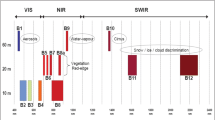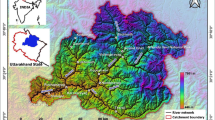Abstract
Land cover/land use (LCLU) maps are essential inputs for environmental analysis. Remote sensing provides an opportunity to construct LCLU maps of large geographic areas in a timely fashion. Knowing the most accurate classification method to produce LCLU maps based on site characteristics is necessary for the environment managers. The aim of this research is to examine the performance of various classification algorithms for LCLU mapping in dry and humid climates (from June to August). Testing is performed in three case studies from each of the two climates in Iran. The reference dataset of each image was randomly selected from the entire images and was randomly divided into training and validation set. Training sets included 400 pixels, and validation sets included 200 pixels of each LCLU. Results indicate that the support vector machine (SVM) and neural network methods can achieve higher overall accuracy (86.7 and 86.6 %) than other examined algorithms, with a slight advantage for the SVM. Dry areas exhibit higher classification difficulty as man-made features often have overlapping spectral responses to soil. A further observation is that spatial segregation and lower mixture of LCLU classes can increase classification overall accuracy.




Similar content being viewed by others
References
Bhattarai, N., Quackenbush, L. J., Dougherty, M., & Marzen, L. J. (2015). A simple Landsat–MODIS fusion approach for monitoring seasonal evapotranspiration at 30 m spatial resolution. International Journal of Remote Sensing, 36(1), 115–143.
Chen, H., Chang, N., Yu, R., & Huang, Y. (2009). Urban land use and land cover classification using the neural-fuzzy inference approach with Formosat-2 data. Journal of Applied Remote Sensing, 3(1), doi:10.1117/1.3265995.
Chen, C., Son, N., Chen, C., & Chang, L. (2011). Wavelet filtering of time-series moderate resolution imaging spectroradiometer data for rice crop mapping using support vector machines and maximum likelihood classifier. Journal of Applied Remote Sensing, 5(1), 053525-053525-15.
De Martonne, E. (1926). In Une Nouvelle fonction climatologique. L’Indice d’aridité (pp. 449–458). Paris: Impr. Gauthier-Villars.
De Moraes, J. F. L., Seyler, F., Cerri, C. C., & Volkoff, B. (1998). Land cover mapping and carbon pools estimates in Rondonia, Brazil. International Journal of Remote Sensing, 19(5), 921–934.
Dixon, B., & Candade, N. (2008). Multispectral land use classification using neural networks and support vector machines: one or the other, or both? International Journal of Remote Sensing, 29(4), 1185–1206.
Fisher, R. A. (1926). The arrangement of field experiments. Journal of the Ministry of Agriculture of Great Britain, 33, 503–513.
Foody, G. M. (2002). Status of land cover classification accuracy assessment. Remote Sensing of Environment, 80(1), 185–201.
Foody, G. M. (2004). Thematic map comparison: evaluating the statistical significance of differences in classification accuracy. Photogrammetric Engineering and Remote Sensing, 70(5), 627–633.
Ghimire, S., & Wang, H. (2012). Classification of image pixels based on minimum distance and hypothesis testing. Computational Statistics and Data Analysis, 56(7), 2273–2287.
Gualtieri, J. A., & Cromp, R. F. (1999). Support vector machines for hyperspectral remote sensing classification. Proceedings of SPIE - The International Society for Optical Engineering, 3584, 221–232.
Halder, A., Ghosh, A., & Ghosh, S. (2011). Supervised and unsupervised land use map generation from remotely sensed images using ant based systems. Applied Soft Computing Journal, 11(8), 5770–5781.
Huang, C., Davis, L. S., & Townshend, J. R. G. (2002). An assessment of support vector machines for land cover classification. International Journal of Remote Sensing, 23(4), 725–749.
Jacqueminet, C., Kermadi, S., Michel, K., Béal, D., Gagnage, M., Branger, F., Jankowfsky, S., & Braud, I. (2013). Land cover mapping using aerial and VHR satellite images for distributed hydrological modelling of peri-urban catchments: application to the Yzeron catchment (Lyon, France). Journal of Hydrology, 485, 68–83.
Jensen, J. R. (1996). Introductory digital image processing: a remote sensing perspective. Introductory digital image processing: a remote sensing perspective. Second edition.
Kavzoglu, T., & Mather, P. M. (2003). The use of back propagating artificial neural networks in land cover classification. International Journal of Remote Sensing, 24(23), 4907–4938.
Kennaway, T. A., Helmer, E. H., Lefsky, M. A., Brandeis, T. A., & Sherrill, K. R. (2008). Mapping land cover and estimating forest structure using satellite imagery and coarse resolution lidar in the Virgin Islands. Journal of Applied Remote Sensing, 2(1), doi:10.1117/1.3063939.
Khatami, R., & Mountrakis, G. (2012). Implications of classification of methodological decisions in flooding analysis from Hurricane Katrina. Remote Sensing, 4(12), 3877–3891.
Lu, D., & Weng, Q. (2007). A survey of image classification methods and techniques for improving classification performance. International Journal of Remote Sensing, 28(5), 823–870.
Luo, L., & Mountrakis, G. (2011). Converting local spectral and spatial information from a priori classifiers into contextual knowledge for impervious surface classification. ISPRS Journal of Photogrammetry and Remote Sensing, 66(5), 579–587.
Mantero, P., Moser, G., & Serpico, S. B. (2005). Partially supervised classification of remote sensing images through SVM-based probability density estimation. IEEE Transactions on Geoscience and Remote Sensing, 43(3), 559–570.
Martinuzzi, S., Vierling, L. A., Gould, W. A., Vierling, K. T., & Hudak, A. T. (2009). Incorporating remotely sensed tree canopy cover data into broad scale assessments of wildlife habitat distribution and conservation. Journal of Applied Remote Sensing, 3(1), doi:10.1117/1.3279080.
Mohammady, M., Moradi, H. R., Zeinivand, H., & Temme, A. (2015). A comparison of supervised, unsupervised and synthetic land use classification methods in the north of Iran. International Journal of Environmental Science and Technology, 12(5), 1515–1526.
Mohammdy, M., Moradi, H. R., Zeinivand, H., Temme, A. J. A. M., Pourghasemi, H. R., & Alizadeh, H. (2014). Validating gap-filling of Landsat ETM+ satellite images in the Golestan Province, Iran. Arabian Journal of Geosciences, 7, 3633–3638.
Mountrakis, G., & Luo, L. (2011). Enhancing and replacing spectral information with intermediate structural inputs: a case study on impervious surface detection. Remote Sensing of Environment, 115(5), 1162–1170.
Mountrakis, G., Im, J., & Ogole, C. (2011). Support vector machines in remote sensing: a review. ISPRS Journal of Photogrammetry and Remote Sensing, 66(3), 247–259.
Neuenschwander, A. L., Magruder, L. A., & Tyler, M. (2009). Land cover classification of small-footprint, full-waveform lidar data. Journal of Applied Remote Sensing, 3(1), doi:10.1117/1.3229944.
Núñez, L., Grosjean, M., & Cartajena, I. (2002). Human occupations and climate change in the Puna de Atacama, Chile. Science, 298(5594), 821–824.
Oommen, T., Misra, D., Twarakavi, N. K. C., Prakash, A., Sahoo, B., & Bandopadhyay, S. (2008). An objective analysis of support vector machine based classification for remote sensing. Mathematical Geosciences, 40(4), 409–424.
Pfanzagl, J. (1994). Parametric statistical theory. Hamböker. Berlin, DE: Walter de Gruyter. 207–208.
Richards, J. A., & Jia, X. (2006). Remote sensing digital image analysis: an introduction. Remote Sensing Digital Image Analysis: An Introduction, 1-439.
Sen, G., Bayramoglu, M. M., & Toksoy, D. (2015). Spatiotemporal changes of land use patterns in high mountain areas of Northeast Turkey: a case study in Maçka. Environmental Monitoring and Assessment, 187(8), 1–14.
Shaw, S. B., Marrs, J., Bhattarai, N., & Quackenbush, L. (2014). Longitudinal study of the impacts of land cover change on hydrologic response in four mesoscale watersheds in New York State, USA. Journal of Hydrology, 519(PA), 12–22.
Skizadeh, M. (2015). Assessment the performance of classification methods in water quality studies, a case study in Karaj River. Environmental Monitoring and Assessment, 187(9), 1–12.
Soffianian, A., & Madanian, M. (2015). Monitoring land cover changes in Isfahan Province, Iran using Landsat satellite data. Environmental Monitoring and Assessment, 187(8), 1–15.
Stehman, S. V. (1997). Selecting and interpreting measures of thematic classification accuracy. Remote Sensing of Environment, 62(1), 77–89.
Szuster, B. W., Chen, Q., & Borger, M. (2011). A comparison of classification techniques to support land cover and land use analysis in tropical coastal zones. Applied Geography, 31(2), 525–532.
USGS, (2004). Phase 2 gap-fill algorithm: SLC-off gap-filled products gap-fill algorithm methodology. Available online at landsat.usgs.gov/documents/L7SLCGapFilledMethod.pdf. Accessed 28 Nov 2010.
Van Der Linden, S., Janz, A., Waske, B., Eiden, M., & Hostert, P. (2007). Classifying segmented hyperspectral data from a heterogeneous urban environment using support vector machines. Journal of Applied Remote Sensing, 1(1), doi: 10.1117/1.2813466.
Vörösmarty, C. J., Green, P., Salisbury, J., & Lammers, R. B. (2000). Global water resources: vulnerability from climate change and population growth. Science, 289(5477), 284–288.
Vorovencii, I. (2014a). A change vector analysis technique for monitoring land cover changes in Copsa Mica, Romania, in the period 1985–2011. Environmental Monitoring and Assessment, 186(9), 5951–5968.
Vorovencii, I. (2014b). Assessment of some remote sensing techniques used to detect land use/land cover changes in South-East Transilvania, Romania. Environmental Monitoring and Assessment, 186(5), 2685–2699.
Walker, N. J., & Schulze, R. E. (2008). Climate change impacts on agro-ecosystem sustainability across three climate regions in the maize belt of South Africa. Agriculture, Ecosystems and Environment, 124(1–2), 114–124.
Wang, Z.-J., Jiao, J.-Y., Lei, B., & Su, Y. (2015). An approach for detecting five typical vegetation types on the Chinese Loess Plateau using Landsat TM data. Environmental Monitoring and Assessment, 187(9), 1–16.
Wentz, E. A., Stefanov, W. L., Gries, C., & Hope, D. (2006). Land use and land cover mapping from diverse data sources for an arid urban environments. Computers, Environment and Urban Systems, 30(3), 320–346.
Xing, E. P., Ng, A. Y., Jordan, M. I., & Russell, S. (2003). Distance metric learning, with application to clustering with side-information. Advances in Neural Information Processing Systems, 505–512.
Zhang, Y., Huang, D., Ji, M., & Xie, F. (2011). Image segmentation using PSO and PCM with Mahalanobis distance. Expert Systems with Applications, 38(7), 9036–9040.
Acknowledgments
The authors would like to thank Matthieu Molinier for his valuable suggestions during writing and development of this manuscript. Also, the authors would like to thank the editorial comments and anonymous reviewers for their helpful comments on the previous version of the manuscript.
Author information
Authors and Affiliations
Corresponding author
Rights and permissions
About this article
Cite this article
Yousefi, S., Khatami, R., Mountrakis, G. et al. Accuracy assessment of land cover/land use classifiers in dry and humid areas of Iran. Environ Monit Assess 187, 641 (2015). https://doi.org/10.1007/s10661-015-4847-1
Received:
Accepted:
Published:
DOI: https://doi.org/10.1007/s10661-015-4847-1




